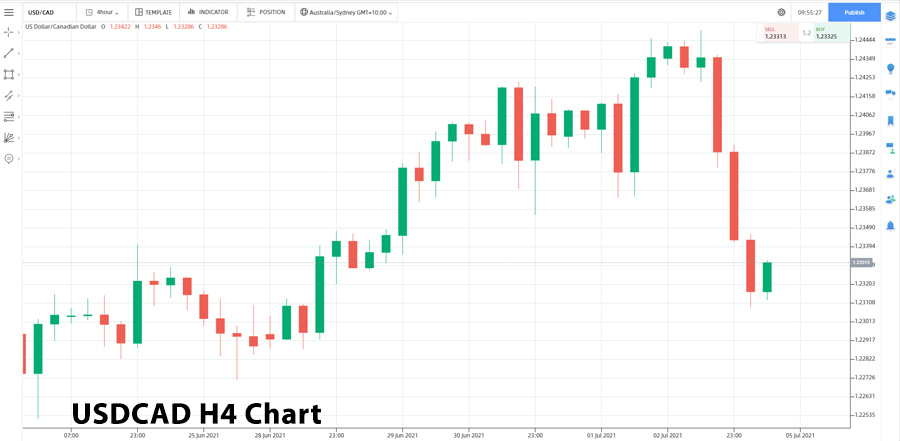Strong US Jobs Report Fails to Lift Dollar, Bond Yields Fall

- Michael Moran , Senior Currency Strategist at ACY Securities
- 05.07.2021 06:30 am trading
CAD, AUD, Risk FX, Commodities Rise, Fed Minutes Next
Summary: Despite a stronger-than-expected US employment gain, the Dollar eased while bond yields fell. The American economy added a total of 860,000 new jobs in June, far outstripping forecasts of 700,000 and an upwardly revised gain of 583,000 (559,000) in May. The Unemployment Rate ticked higher to 5.9% (5.8%). The Dollar surged immediately following the release but lost steam, gradually easing to close lower against its rivals. Risk appetite rallied, lifting stocks, bonds, commodities, and related currencies. A favourite gauge of the Greenback’s value against a basket of 6 major currencies, the Dollar Index (USD/DXY) slid 0.38%, closing at 92.25 from 92.55. Risky currencies advanced, led by the Australian Dollar, up 0.7% to 0.7527 (0.7464 Friday). Against the Canadian Loonie (best performing major) the Greenback slumped 1.13% to 1.2325 from 1.2442. The USD/JPY pair slid 0.53% to 111.02 (111.57) weighed by a 4-basis point drop in the US 10-year bond yield to 1.42%. Sterling soared to a 1.3832 close from its Friday opening of 1.3757 and an overnight low at 1.3731. The Euro rose moderately to finish at 1.1865 (1.1845 Friday) and a low at 1.1807 low. The Greenback was mostly lower against the Asian and Emerging Market currencies. USD/CNH (Dollar – Offshore Chinese Yuan) closed little-changed at 6.4710 from 6.4735. The US Dollar eased against the Singapore Dollar (USD/SGD) to 1.3465 from 1.3480. Commodity prices climbed. Silver rallied to USD 26.37 from USD 26.00. Wall Street stocks finished higher. The DOW closed at 34,790 (34,637 Friday) while the S&P 500 gained 0.7% to 4,350 (4,320).
Other global bond yields closed lower. Germany’s 10-year Bund yield settled at -0.24% from -0.20% Friday. Australian 10-year treasury rate fell 4-basis points to 1.47%. Japan’s 10-year rate was flat.
Data released Friday saw Eurozone PPI rise to 1.3% in May, beating forecasts of 1.2%. Canada’s May Building Permits fell by -14.8% from April’s -0.5%. Canada’s Trade Balance in May turned into a Deficit (-CAD 1.4 billion), against expectations of a Surplus of +CAD 0.37 billion. Canada’s June Manufacturing PMI slid to 56.5 from 57.0 in April. US June Wages (Weekly Hourly Earnings) eased to 0.3% from a downwardly revised 0.4% in May, and lower than expectations of 0.4%. The US May Trade Deficit rose to -USD 71.2 billion from a previous deficit of -USD 68.9 billion. US May Factory Orders rose to 1.7% from -0.6% in April, beating estimates at 1.6%.
- AUD/USD – The Australian Battler recovered sharply against the Greenback to a 0.7527 close in New York. Earlier in the session, the Aussie slumped to 0.7444 immediately following the release of the US Payrolls report, a new yearly low. The Aussie rebounded sharply as risk appetite rose and the Greenback eased.
- USD/CAD – Canada’s Loonie outperformed despite mostly weaker-than-expected Canadian economic data (Building Permits, Trade Balance and Manufacturing PMI). The Greenback slumped to close at 1.2325 from 1.2442. Overnight low traded was 1.2300 while the overnight high was at 1.2450 which followed the release of the US Payrolls report.
- EUR/USD – The Euro slid to an overnight low at 1.1807 following the release of a better-than- expected US Employment report. The shared currency then grinded its way higher to close at 1.1865, 0.10% higher than its 1.1847 opening on Friday.
- USD/JPY – Against the Japanese currency, the US Dollar ended 0.53% lower to 111.00 at the New York close (111.56 Friday opening). The US 10-year Treasury yield drop to 1.42% from 1.46% weighed on this currency pair. USD/JPY hit its overnight high at 111.66 right after the US Payrolls report was released.
On the Lookout: The week ahead is a busy one with the highlight coming early Thursday morning in Sydney (4.00 am). Markets will be looking at the release of the FOMC minutes from the Federal Reserve’s June policy meeting. The US celebrates its July 4 Independence Day with holiday today.
The economic calendar though is a busy one with the release of global Services PMI’s today. Australia kicks off with its Markit Services PMI for June. (May Services PMI was at 58.0, no forecasts given). Australia just released its June AIG Construction Index report which fell to 55.5 from May’s 58.3. Japanese Jibun Final Services PMI for June follows (May PMI was at 46.5. New Zealand follows with its ANZ June Commodity Prices (f/c 1.2% from 1.3%). Australia’s May Building Permits follow (f/c -5.0% from -8.6%). Next is Australian May Retail Sales (f/c 0.1% from 0.1% m/m). China releases its Caixin Services PMI (June f/c 54.8 from 55.1). Europe follows with Italian Services PMI (f/c 56.3 from 53.1), French Services PMI (f/c 57.4 from 56.6), German Services PMI (f/c 58.1 from 52.8) and Eurozone Services PMI (f/c 58.0 from 55.2). The UK follows with its June Services PMI (f/c 61.7 from 62.9). Finally, Canada releases its Bank of Canada Business Outlook Survey.
Trading Perspective: The US Dollar failed to gain from the better-than-expected gain in US jobs for June. In the past, a number like that would see the Dollar rocket higher. Many traders were not impressed and viewed the overall Payrolls report as mixed (Unemployment rate rose to 5.9%). While the Payrolls report pointed to a continued rebound in the US economy, bond markets saw the data as not strong enough to raise inflation concerns. The benchmark US 10-year treasury yield dropped 4 basis points to 1.42%. Which sapped the Greenback of its strength against other major and minor currencies. Technically, the Greenback’s rally was stretched, and the reversal that followed was inevitable. This week the focus turns to the release of the latest Federal Reserve’s meeting (June).
The 4th of July US Independence Day holiday kicks off the Northern Hemisphere summer break. Which normally ushers in the dreaded “summer doldrums”, the end of which traditionally comes during the Fed’s August symposium in Jackson Hole, Wyoming. However, the release of June FOMC meeting minutes may ignite volatility.
- AUD/USD – The Aussie Battler faces a test today with the release of Australian Retail Sales, Markit Services PMIs and Building Approvals. AUD/USD closed 0.65% higher at 0.7527 from Friday’s 0.7464. Immediate resistance today can be found at 0.7540, 0.7570 and 0.7600. Immediate support lies at 0.7500, 0.7470 and 0.7440. The Aussie traded in a 0.7444-0.7524 range overnight. A better-than-expected result in the Aussie data releases today could see a test of 0.7570 first up. Any disappointments will see 0.7500, perhaps 0.7470. The Aussie feels well supported. Look to trade a likely 0.7480-0.7540 range today. No biases today, happy to trade both sides of the range.
- USD/JPY – soared to an overnight high at 111.66 immediately following the release of the US Payrolls report. The US Dollar then spent the rest of the North American session sliding to its 111.00 close not far from its overnight low traded at 110.95. The 4-basis point fall in the US 10-year bond yield weighed on this currency pair. Any bounces in USD/JPY will be limited if the US 10-year rate stays where it is. Immediate resistance lies at 111.30 followed by 111.60. Strong resistance can be found at 111.00. Immediate support can be found at 110.80 and 110.50. Look for a likely trade today between 110.90-111.40. Prefer to sell rallies today.
- USD/CAD – Canada’s Loonie had the biggest gain versus the Greenback compared to the other currencies. This was despite weaker Canadian economic data. USD/CAD rallied to 1.2450 after the US Jobs report was released. The Greenback then slid to an overnight low at 1.2300 before bouncing back a tad to finish at 1.2325. USD/CAD has immediate support at 1.2300 followed by 1.2270 and 1.2240. Immediate resistance lies at 1.2350 followed by 1.2380 and then 1.2410. Looking to buy USD dips in a likely range today of 1.2300-1.2370.

(Source: Finlogix.com)
- EUR/USD – The Euro finished 0.10% higher against the US Dollar after an initial fall to 1.1807 overnight low immediately following the release of the US Jobs number. EUR/USD then spent the rest of the session grinding higher to a 1.1874 overnight peak before settling to its 1.1865 close. EUR/USD has immediate resistance at 1.1880 followed by 1.1920. Immediate support can be found at 1.1840 and 1.1810. Euro area and Eurozone Services PMI’s are released later today with forecasts mostly better than the previous month. Could be in for a disappointment if those numbers are weaker. Looking for consolidation in a likely range today of 1.1810-1.1880. Prefer to sell into any Euro strength.
While Friday’s session fizzled out, there was some choppy trading into and after the US Payrolls release. While we may have a slow start today, things should pick up later and into the week. Happy days! Have a good Monday start. Happy trading all.

























